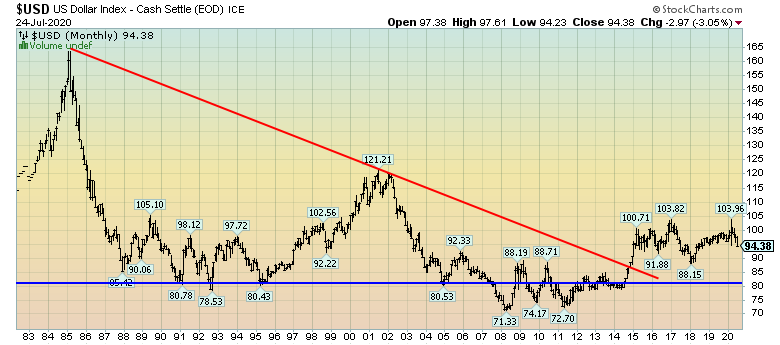Long-Term Decline In The U.S. Dollar
I have extensively written of the decline in the U.S. Dollar and its economic and financial implications. This commentary can be found under the “U.S. Dollar Commentary” category.
For reference, here is the monthly U.S. Dollar chart from 1983. This clearly shows a long-term weakness, with the blue line showing technical support until 2007, and the red line representing a (past) trendline. The current value (as of July 24, 2020) is 94.38:
(charts courtesy of StockCharts.com; annotations by the author)
(click on charts to enlarge images)

[Updates of this chart as well as others can be seen under the “US Dollar” tag]
Reasons For A Falling U.S. Dollar
As of this writing (July 2020) the belief of a coming “Dollar collapse” is very uncommon. However, there are many fundamental and technical reasons supporting this conclusion.
In the October 31, 2013 post (“U.S. Dollar Concerns“) I wrote of various reasons why a currency is vulnerable to a substantial decline.
Here are those reasons:
- Very low interest rates
- Truly outsized interventions (including “money printing”);
- Ongoing large budget deficits and deficit spending “as far as the eye can see”
- Substantial federal debt; depending upon the specific estimate used, at multiples of GDP when viewed on an accrual basis
- Many exceedingly large asset bubbles – and the future implications
- An economic system highly vulnerable to financial instability
In addition to those reasons, there are other reasons as well, including:
- poor economic policies
- loss of confidence in the nation and/or national economy
- protracted economic weakness
- extensive (in severity) economic weakness
- (adverse) currency flows
- other issues that can be hard to identify
With regard to the last point, because the causes in currencies’ movements can be hard to determine, it can be hard to know what actions (“all things considered”) are needed to reverse a currency’s decline.
As I mentioned in the October 31, 2013 post, the past and current U.S. economic condition exhibit classic (pre)conditions to substantially depreciate the currency.
Acceleration In The Decline Of The U.S. Dollar
As I have written, I continue to believe that this U.S. Dollar decline will accelerate and will take the U.S. Dollar (as measured by the U.S. Dollar Index) to new record lows, substantially below the previous low of approximately 71. I continue to believe the following, as seen in the “U.S. Dollar Target” July 30, 2010 post:
In summary, I continue to believe the U.S. Dollar is highly vulnerable to a substantial decline. This decline has the potential to be rather open-ended in nature, as supported by both technical and fundamental factors. Once the 70-level is broken, the U.S. Dollar decline would likely become very pernicious and levels of 50, as well as substantially below, should be considered possibilities.
Due to what has happened since that July 30, 2010 post was written, the vulnerability to a severe Dollar decline – what may be considered a “collapse” – has increased.
Consequences Of A Falling Dollar
A Dollar collapse will have substantial implications across many aspects of the U.S. as well as global economic and financial system. The collapse will both cause and accompany (severe) economic weakness, and it will be the source of innumerable hardships. As seen in many economies that have experienced extensive decline and duress, perhaps the fastest and most assured way of getting into severe economic trouble is to have a rapid and extensive currency depreciation.
As I wrote in the aforementioned October 31, 2013 post:
A substantial Dollar decline will have many ill-effects, and will likely be akin to opening a “Pandora’s Box” of various economic and financial problems. This currency weakness will create an entirely new set of severe economic problems and challenges, in addition to other problems that will almost certainly coexist at the same time of the Dollar’s decline.
(posted July 27, 2020)